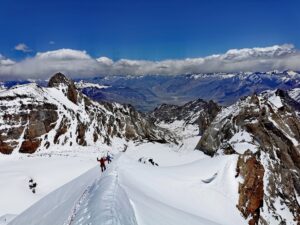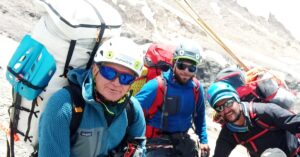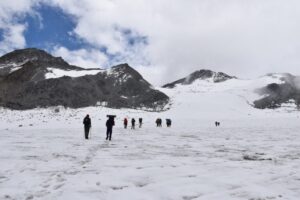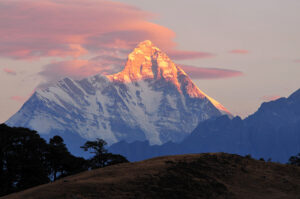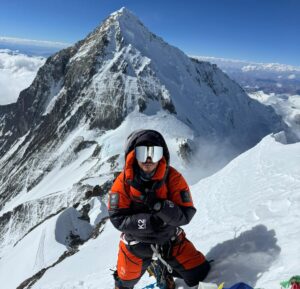Today’s summiters have safely reached Camp 3. They will rest and rehydrate before setting off tomorrow for Base Camp.
Beginning at 8 pm on Wednesday, they needed 19 hours to summit in tough, dangerous conditions. After two weeks of bad weather and significant snowfall on Wednesday, Manaslu was overloaded with fresh, unstable snow. They climbed and descended with avalanches cascading around them.
The forecast is worsening, so tomorrow they will have to make every effort to reach Base Camp. Just how much risk did this summit push involve? Was it worth it?

Kristin Harila safely reached Camp 3 on Manaslu. Photo: Instagram
“We wanted to summit Manaslu now to avoid the crowds…waiting in Base Camp,” Harila explained in her summit message. “Heavy snowfall and high risk of avalanches made this ascent challenging, so I am glad we made it,” she admitted.
Crowds are potentially a problem on Manaslu this season, but few went for the summit today. Nearly all climbers who reached Camp 3 earlier this week retreated to Base Camp. They felt that conditions were too risky and the weather window too short.

Multimodel forecasts for the summit of Manaslu by Meteoexploration.com, showing bad weather tomorrow and all weekend.
Why rush?
Harila, currently trying to beat Nirmal Purja’s speed record, had no time to waste. Her deadline to complete all 14 8,000’ers is November 2. How practical it will be for hundreds of climbers to reach the delicate, picky true summit of Manaslu in a mass good-weather push is unknown. Her impatience to notch that summit and move on to the last two on her list, Cho Oyu and Shishapangma, was understandable.
But most Manaslu climbers, especially if they are not planning to summit other peaks, can afford to wait in Manaslu’s huge, comfortable Base Camp for two months. Helicopters are available for those choosing to fly temporarily to Samagaon or Kathmandu for some R ‘n R.
Climbers going without supplementary oxygen need at least three acclimatization rounds, while those using bottled gas can make it with two trips up. They can also afford to wait longer on the mountain itself for their turn to stand on the narrow summit.
What no one can afford though, is to be caught in an avalanche. Deadly slides, either from unstable slabs after snowfalls or from falling seracs, are a real threat on Manaslu. Eight people died in 2012 when a chunk of serac from the summit area triggered an avalanche that swept away Camp 3 and all who were there. For more about that tragic accident, read this article by Mark Horrell and watch the video below.
Today, climbers in Base Camp have seen several avalanches roaring down the mountain. They have also seen a helicopter rescuing one climber who had chosen to push for the summit, Alexandra Wichstrom. The Norwegian woman had to be helped, then airlifted, according to reports. Some climbers in Camp 3 helped with the rescue.
Back from the true summit
A crucial question is whether today’s climbers stood on Manaslu’s true summit. Typically, summit pictures have to wait until the climbers return to Base Camp. Pioneer Adventures, for example, illustrated the summit success of Sanu Sherpa, Mingma Thinduk Sherpa, and Hu Tao with some photos from last year. Kristin Harila’s team likewise chose a picture of the Norwegian climber on K2 this summer.
For those keen to check the rocky features near the summit, here is a frame of the video shot by Mingma G from last year. The outcrops show the usual point where the fixed ropes ended and clients stopped.

Frame of Mingma G’s video from Manaslu’s true summit.
What about the rest?
We are not aware of any other teams attempting to summit tomorrow. Forecasts show bad weather until the next window, between September 29 and October 2. Then the key question is, what about the traffic jams? Hundreds of climbers are waiting for their chance.
“It’s crazy,” Warner Rojas of Costa Rica told ExplorersWeb from Base Camp. “On Tuesday and Wednesday, when the weather improved slightly and everybody went up, we had to wait one hour at some sections before Camp 2. On the following day, the traffic jam was the same, at the same places, on the way down.”

Climbers wait in a pass between seracs before Camp 2. Warner Rojas says he had to wait an hour at this spot. Photo: Warner Rojas
“There are far too many people, and some are clueless about mountaineering,” Roja added. “They are unable to fix their crampons and are terrified of a short rappel.”
Although many climbers are completely dependent on their Sherpa guides and progressing very slowly, none will be content this year with the foresummit. What will happen as the ridge gets thinner, the climbing more exposed, and the ropes fewer? There will be many such questions from Manaslu in the days ahead.
Especially: How many people, going up one route during a few days in late September, and summiting via a short but highly technical section, can the mountain physically host?

